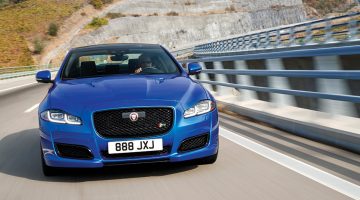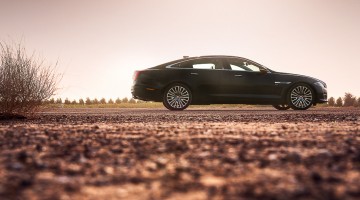Bravely, Jaguar is launching its beautiful estate car in a region obsessed with SUVs. It’s a car that merits serious consideration
| Engine | Power | Torque | 0-100kph | Top speed | Weight | Price |
|---|---|---|---|---|---|---|
| Supercharged V6, 2995cc | 360hp @ 6500rpm | 332lb ft @ 4500rpm | 5.5sec (claimed) | 250kph | 1760kg | from $80,000 |
| Individual, stylish and genuinely practical | |
| Cabin not quite as well crafted as its German rivals |
All it takes is a few minutes on Middle Eastern roads to come to the firm conclusion that in this part of the world the SUV is king. Unlike Europe the estate car is very much a bit player here, and other than the ever-present Emirates airline chauffeur driven Mercs and Volvos they are a rather rare sight. Thankfully Jaguar has chosen to fly in the face of this trend and taken the brave decision to bring its rather excellent XF Sportbrake to the region, and if first impressions are anything to go by it just might be the perfect antidote for those who haven’t bought into the whole SUV thing.
Let’s not forget that Jag has a pretty good SUV of its own, but what the XF Sportbrake gives up to the F-Pace in terms of a commanding driving position and fashionable appeal, it more than makes up for in terms of luggage capacity and driver fun. In fact, the estate feels more in tune with Jaguar’s old adage of grace, pace and space. The Sportbrake – Jaguar’s fancy name for an estate car – offers a practical 565 litres of boot space, which can be extended to a cavernous 1,700 litres with the 40:20:40 rear seats folded flat.
On the inside, as you’d expect, the cabin is the same as you’d find in the saloon, which means a simple, if a tad uninspiring cockpit and levels of fit and finish far beyond that of the previous model. That said, the Jaguar can’t quite match the overall quality and feel of its German rivals, although it doesn’t miss by much. The driving position is suitably sporty, helped by the raised centre console, which provides a terrific sense of occasion, while the optional panoramic sunroof allows the Portuguese sunlight to flood into the cabin. It’s a must-have option, especially as it can be paired with gesture control – a first for Jaguar.
On the outside, the Sportbrake is identical to the XF saloon until you reach the B-pillar, where the roofline stays high and continues past to the rear, to reveal a traditional estate rear end. The tailgate is dominated by the F-Type-inspired rear light clusters, and to my eyes, this is the best-looking estate car you can buy, even managing to eclipse the very stylish Volvo V90. That’s especially the case when adorned with the R-Sport body kit of our test car
Things get even better when you hit the road, for few estate cars are as good to drive as the XF Sportbrake. Like the saloon, it’s based on lightweight aluminium architecture. In fact, with the estate version weighing just 115kg more than the saloon, you’d be hard-pressed to notice any difference at the wheel. All Sportbrake models feature air suspension at the rear, which helps to ensure a level chassis and ride height, even when the car is fully laden. No chance of the freshly purchased groceries, or worse still, the family dog, enjoying a less than perfect ride home from the supermarket, then. In fact, the Sportbrake offers a near-perfect blend of comfort and dynamics. Even with the 20-inch alloy wheels, the ride quality retains that trademark Jaguar waft.
But don’t for a second think that means the XF Sportbrake is soft, for on the twisting B-roads of our test route, it responds with lightning-quick cornering, tight body control and bags of grip, especially if you opt for the all-wheel drive version that I’m driving. Flick the suspension into Dynamic mode, and the Sportbrake fidgets around a little more, but rarely feels too firm. Jaguar’s typical chassis prowess is now on full display as we snake through northern Portugal’s rolling landscapes. Meanwhile the XF steers with on-centre alacrity and just the right amount of power assist, while brake-based torque vectoring helps turn-in, although it also leaves the pads and discs radiating heat at the end of a particularly spirited run.
While Jaguar will be bringing the rather sluggish 2-litre four-pot to the region as an entry-level version, the more potent XF-S is the more intriguing option. Under the bonnet is the excellent 3-litre supercharged V6 found in the F-Type, paired with an eight-speed automatic transmission. The 380hp powerplant’s 332lb ft of torque feels palpable at low rpms and pulls strongly throughout the rev range. The sprint to 100kph requires a claimed 5.5 seconds, which is just a couple of tenths more than a similarly endowed XF saloon. The engine sound isn’t particularly loud – those big, round exhaust pipes apparently prefer to be seen, not heard – but the ability to deliver healthy, stealthy acceleration is entirely in keeping with the Sportbrake’s persona.
So is this the perfect sporting estate, then? It’s undoubtedly one of the best-in-class when it comes to ride and handling, while those sexy looks combine with genuine practicality to make it a very enticing proposition. Nevertheless, Jaguar is undoubtedly taking a chance by bringing an estate version of the XF to the SUV-mad Middle East, but if you ask me the move hasn’t come a moment too soon. Hopefully our region will reward that bravery by finally sitting up and taking notice that the Sportbrake is more than just a quirky alternative to an SUV. In many ways it’s genuinely better


